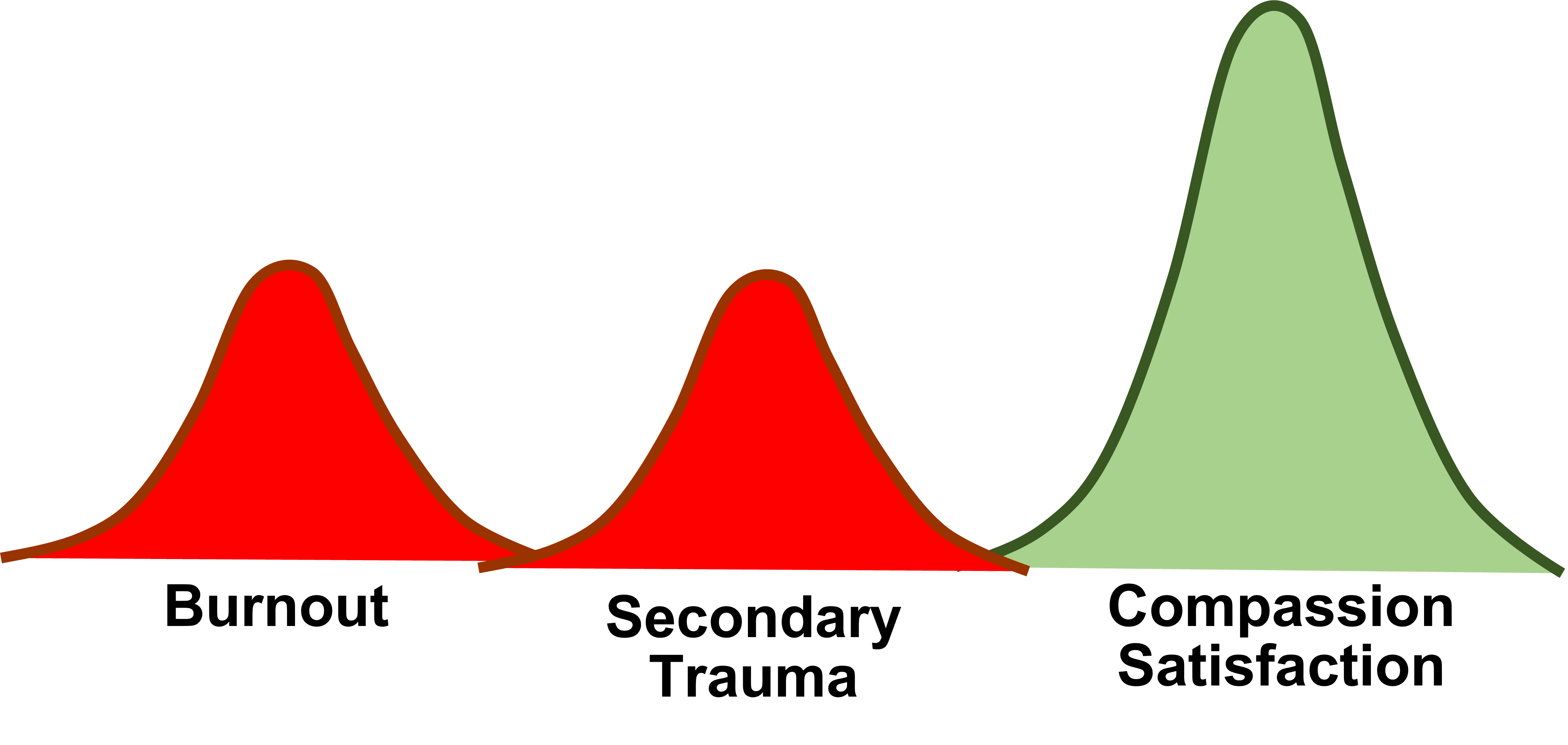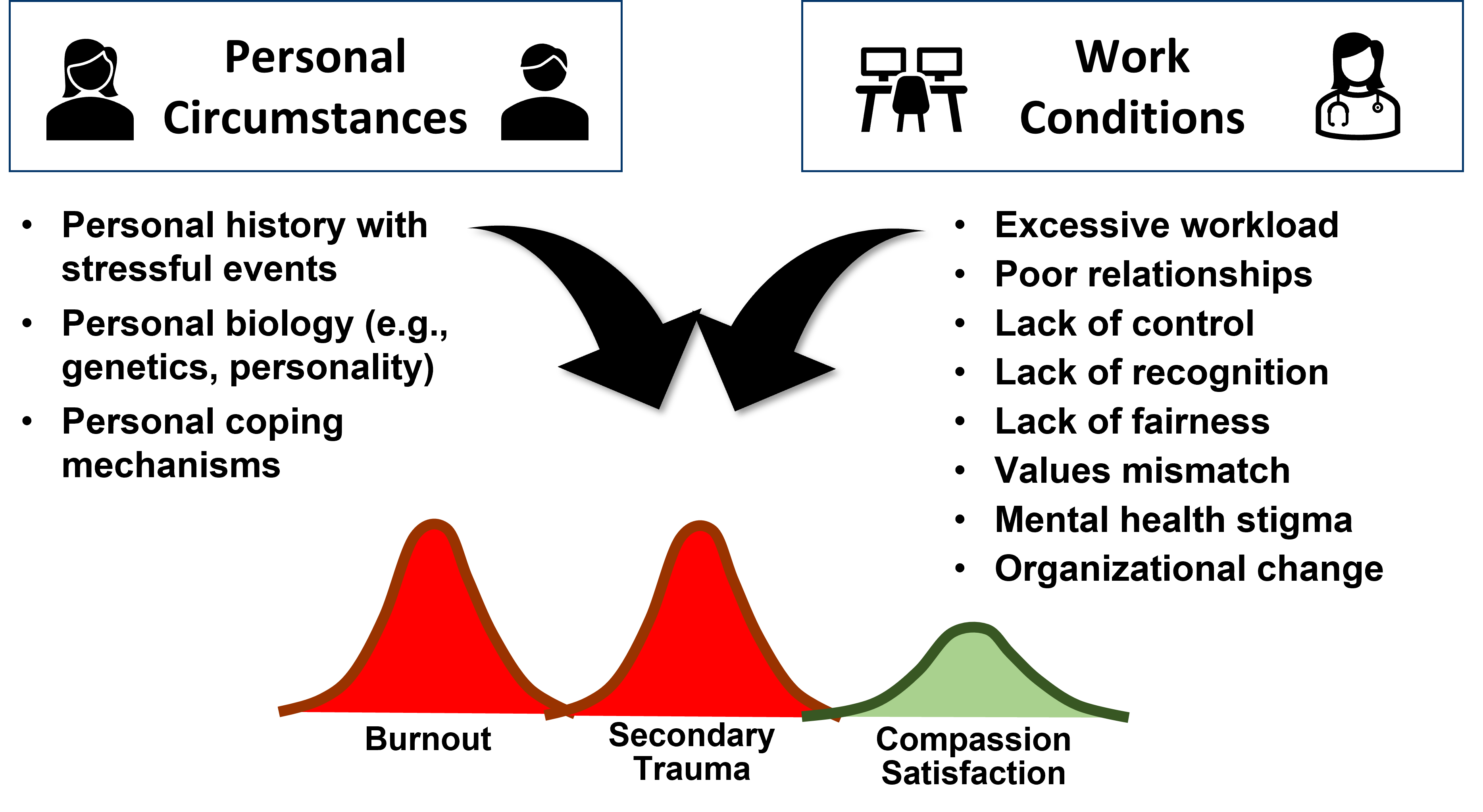In part 1 of this series, we learned that compassion fatigue results from the convergence of 3 factors: burnout,secondary trauma, and compassion satisfaction.

Is anyone surprised that burnout levels are high right now?
No.
Back in 2016, the Critical Care Societies Collaborative (CCSC) estimated that up to a third of critical care nurses were burned out. Those rates have climbed to 50% in the Covid-19 era.
Get FREE training on Burnout & the Great Resignation
Leaders, are your employees leaving because they are burned out? Click the button to get research-based tools to extinguish burnout and retain your workforce!
Frontline healthcare staff are also now dealing with significant trauma. In a recent Lancet article, one ICU nurse was quoted as saying, “I can’t really remember my journeys home, I think I cried, pretty much all of the time.”
Interestingly, compassion satisfaction – the joy and fulfillment workers experience in caregiving – increased during the early months of the pandemic as healthcare workers found an even stronger sense of purpose in their work. Researchers believe this likely protected them from even higher levels of compassion fatigue.
Now that healthcare staff are dealing with bone-grinding fatigue and the frustrations of navigating an uneven vaccine landscape, it remains to be seen if compassion satisfaction will stay high or slide down.
Workplace Stress Fuels Compassion Fatigue
We’ve already covered the personal sources of stress that may feed compassion fatigue.
Workplace conditions can turn the stress dial up even further. Consider the following sources of stress that are known to feed feelings of burnout:

Workplace Conditions
- Excessive workloads: Overwork and overwhelm is a problem for many, especially in the Covid-19 era. At the very least, this leads to poor work-life balance. At worst…well, the World Health Organization recently reported that each year, three quarters of a million people die from physical ailments directly attributable to working long hours.
- Perceived Lack of Control: Feeling that we lack autonomy and are being micromanaged can be particularly de-motivating and stressful.
- Lack of Recognition: Recognition starts with paying workers what they’re worth, but it doesn’t end there. Compensation aside, everyone likes an occasional “Atta boy/girl,” to know that their contributions are recognized and valued.
- Poor relationships: Poor relationships and poor communication are among the top workplace stressors. These can lead to other stressful situations like poor collaboration, poor teamwork, and growing distrust.
- Lack of fairness: This can include unfair pay, increased paperwork or workloads, no support systems for dealing with burnout and/or compassion fatigue, and organizational changes that bring short-term benefits but long-term losses to the organization.
- Values mismatch: Inc.com columnist Jessica Stillman summarized this well: “…Jobs that are most likely to cause burnout are the ones where we feel in conflict with our deepest commitments.” In the Covid-19 era, healthcare practitioners are struggling with a particular type of values mismatch called “moral injury.” This is when they witness traumatic events that go against their own moral code, such as watching patients die because they are not vaccinated or because the hospital has simply run out of resources to care for them.
- Mental health stigma: Burnout and compassion fatigue result in higher rates of anxiety, depression, and PTSD. It also results in higher rates of suicidal thoughts and behaviors. When mental health issues are ignored, they cannot be resolved. This can launch employees into a downward spiral as they not only grapple with work-related trauma but also mental health stigma and disenfranchised grief.
- Organizational Change: Change is inevitable – it can even be critical in the face of crisis and trauma. But organizational changes will, in and of themselves, add to employees’ stress load. Researchers have identified specific types of stress that employees may feel before, during, and after organizational change. Examples include feelings of uncertainty, unclear roles, poor communication, or lack of input into organizational decisions.
Disenfranchised Grief and Compassion Fatigue
In the wake of Covid-19, grief permeates much of the world. Workplaces are struggling to provide support for those who have recently lost loved ones.
When workers feel they have nowhere safe to go to experience and grieve their loss, this is called disenfranchised grief.
Workers can feel this in three ways:
- Empathically: Others simply fail to understand the workers’ grief and provide space and emotional support for the grief.
- Politically: Workplace policies may limit workers’ ability to grieve or even punish them in some way. Workers may also feel stigmatized when experiencing loss-related anxiety and depression.
- Ethicallly: Workers’ grief may be demeaned or treated disrespectfully.
5 Ways to Help Employees Through Compassion Fatigue
Organizational leaders can dramatically reduce the impact of compassion fatigue by addressing the factors listed above. The list of suggested strategies below isn’t exhaustive, but it’s a good start:
1. Make room for grief.
We experience grief in response to any kind of loss. The most obvious kind of loss is death, but humans will also grieve the loss of a job, loss of an important life role, loss of possessions, loss of safety or security, and loss of connection to others.
In an insightful article for Harvard Business Review, psychiatrist Dr. Gianpiero Petriglieri wrote about making space for grief in the Covid-19 era.
He notes that grief is not only pervasive right now; it is also multi-layered. We have not just lost loved ones and patients – we have also lost connection with each other.
Virtual teams are definitely on the rise. My husband, for example, has been working from our dining room table for about 18 months now. But Dr. Petriglieri reminds us that “working this way involves a loss too, that of physical proximity.”
Make room for grief by acknowledging that it can come in a myriad of forms.
Also, make room for grief by offering patience and empathy. It’s normal to grieve in times of tumultuous loss. It’s also normal to feel anxious about the uncertainty that such loss brings to our lives. Allow workers the space they need to work through these natural emotions. Share your experience as well – this can strengthen bonds and trust in the workplace.
2. Create a culture of well-being.
We’ve all heard about the “Great Resignation” by now: the record-breaking millions of employees walking away from their workplaces. Why did they quit? According to a Limeade survey, the #1 reason was burnout.
Many left without even having another job lined up. According to Limeade, these individuals were nearly twice as likely to say that they left because their workplace was hurting their mental health.
The solution is to change the culture.
Creating a culture of wellbeing starts with a firm commitment and modeling by leadership. These leaders will understand the importance of providing mental health services, not just in response to crisis situations, but proactively as well.
They will also understand that wellbeing is not just about encouraging everyone to do yoga or eat right. A culture of wellbeing will also address the risk factors we just talked about, like overwork, poor work-life balance, lack of control or trust, etc.
3. Connect and care for workers.
This is something I’ve blogged on before. Read this for a 3-step crisis management plan, and here’s another resource for “stress first aid.”
4. Provide flexibility and control.
One key way to help employees through crisis is to boost their own sense of control. Workers who believe they have the skills and capacity to overcome a crisis generally come out of it better than those who don’t.
Leaders can instill this confidence by allowing workers as much flexibility and control as possible. And workers are actively looking for this flexibility right now.
I go into more detail about this in a leader’s playbook available in my online store, but here are some basics:
Ask questions. “What are you juggling right now?” “Where would you like more control in your work?” “Where would you like more flexibility?”
Express appreciation. In the face of compassion fatigue, statements of appreciation become lifelines of encouragement and hope. “We couldn’t have done this without you.” “We are grateful for you.”
Take action. “Because we appreciate you, we are working hard to meet your needs for flexibility and control. Here’s what we’re doing right now…” Many CEOs have heard and are already acting on this guidance. 80% of 117 CEOs surveyed by Fortune and Deloitte have begun offering more flexible work arrangements like virtual work options and less travel.
5. Lead change wisely.
We have all witnessed massive change as all industries struggle to support employees during the Covid-19 pandemic.
The goal is to lead change wisely.
This topic could easily be a blog post by itself – well, a whole blog, really. Here I will simply say that wise leaders proactively address the evolving needs of their teams during organizational change.
Organizational psychologist Anna Kraft has written a great article on this subject. She describes 4 phases of organizational change:
- During the initial, exploratory phase of a large change initiative, employees will be stressed due to uncertainty. They don’t know what to expect and may be hearing rumors and conflicting information. The antidote to this stress is stability, which leaders can provide via open, receptive communication, put rumors to rest, and hear out concerns.
- During the preparatory phase, employees will feel stressed because they are trying to figure out what the change will mean for them. Leaders provide the antidote of support by continuing to hear out concerns and highlighting the positive opportunities the change will bring.
- During the implementation phase, it can take a while to work out the kinks of a change. Employee stress levels may rise as they become impatient and frustrated. The antidote is balance – leaders keep team members focused on the long-term gains of the change, therefore balancing out the short-term frustrations.
- During the final phase, leaders and teams debrief the merits of the change and the methods used to implement the change. The employees’ main need during this phase is acknowledgement – they need to know that their contributions matter and they will continue to be valued at the organization. Leaders can go a long way in reducing burnout by providing this crucial feedback, acknowledging and expressing appreciation for everyone’s hard work.
Summary and Resources
Ohio University has a great resource page on compassion fatigue — check it out here.
This is such a key issue right now that I’ve created a corporate toolkit as well. You can find it in my online shop, but if you want to try it out first, I’ve created a FREE sample that you can download below. I made sure the free version still provides tons of value, including:
- Summaries of the three factors that create compassion fatigue;
- Recommended assessment tools for each factor;
- 22 specific strategies to use for each factor; and
- Two fillable pdf worksheets from the corporate toolkit: 1) three factors drive compassion fatigue and 2) signs and symptoms of compassion fatigue.
Check it out here:

